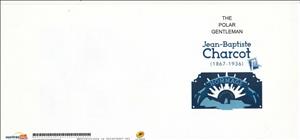Booklet: Jean Baptiste Charcot Polar Gentleman 1867-1936 (Personalized and Private Mail Stamps 2016)
Jean Baptiste Charcot Polar Gentleman 1867-1936 (Personalized and Private Mail Stamps 2016)
25 November (Personalized and Private Mail Stamps ) within release France : Collector. Charcot Polar Explorer goes into circulation Booklet Jean Baptiste Charcot Polar Gentleman 1867-1936 face value 4*Prioritaire No Face Value
| Booklet Jean Baptiste Charcot Polar Gentleman 1867-1936 in catalogues | |
|---|---|
| Colnect codes: | Col: FR-MON 2016-53 |
Booklet is square format.
Issued at the Polar Adventure Fair in Ouistreham by the Stamp ClubAlso in the issue France : Collector. Charcot Polar Explorer:
- Stamp - Charcot on bord the Francais face value Prioritaire;
- Stamp - Hommage Pourquoi Pas? face value Prioritaire;
- Booklet - Jean Baptiste Charcot Polar Gentleman 1867-1936 face value 4*Prioritaire;
- Stamp - Jean Baptiste Charcot with the seagull Rita face value Prioritaire;
- Stamp - The Pouquoi Pas? in the ice face value Prioritaire;
Booklet Jean Baptiste Charcot Polar Gentleman 1867-1936 it reflects the thematic directions:
Exploration is the process of exploring, an activity which has some expectation of discovery. Organised exploration is largely a human activity, but exploratory activity is common to most organisms capable of directed locomotion and the ability to learn, and has been described in, amongst others, social insects foraging behaviour, where feedback from returning individuals affects the activity of other members of the group.
Exploration is the process of exploring, an activity which has some expectation of discovery. Organised exploration is largely a human activity, but exploratory activity is common to most organisms capable of directed locomotion and the ability to learn, and has been described in, amongst others, social insects foraging behaviour, where feedback from returning individuals affects the activity of other members of the group
An exposition, in the most general sense, is an organized presentation and display of a selection of items. In practice, exhibitions usually occur within museums, galleries and exhibition halls, and World's fairs. Exhibitions can include many things such as art in both major museums and smaller galleries, interpretive exhibitions, natural history museums and history museums, and also varieties such as more commercially focused exhibitions and trade fairs.
Famous People refers to the fame and public attention accorded by the mass media to individuals or groups or, occasionally, animals, but is usually applied to the persons or groups of people (celebrity couples, families, etc.) themselves who receive such a status of fame and attention. Celebrity status is often associated with wealth (commonly referred to as fame and fortune), while fame often provides opportunities to make money.
A modern sailing ship or sailship is any large wind-powered vessel. Traditionally a sailing ship (or simply ship) is a sailing vessel that carries three or more masts with square sails on each. Large sailing vessels that are not ship-rigged may be more precisely referred to by their sail rig, such as schooner, barque (also spelled "bark"), brig, barkentine, brigantine or sloop. There are many different types of sailing ships, but they all have certain basic things in common. Every sailing ship has a hull, rigging and at least one mast to hold up the sails that use the wind to power the ship. The crew who sail a ship are called sailors or hands. They take turns to take the watch, the active managers of the ship and her performance for a period. Watches are traditionally four hours long. Some sailing ships use traditional ship's bells to tell the time and regulate the watch system, with the bell being rung once for every half hour into the watch and rung eight times at watch end (a four-hour watch). Ocean journeys by sailing ship can take many months, and a common hazard is becoming becalmed because of lack of wind, or being blown off course by severe storms or winds that do not allow progress in the desired direction. A severe storm could lead to shipwreck, and the loss of all hands. Sailing ships are limited in their maximum size compared to ships with heat engines, so economies of scale are also limited. The heaviest sailing ships (limited to those vessels for which sails were the primary means of propulsion) never exceeded 14,000 tons displacement. Sailing ships are therefore also very limited in the supply capacity of their holds, so they have to plan long voyages carefully to include many stops to take on provisions and, in the days before watermakers, fresh water.
A ship is a large watercraft that travels the world's oceans and other sufficiently deep waterways, carrying passengers or goods, or in support of specialized missions, such as defense, research and fishing. Historically, a "ship" was a sailing vessel with at least three square-rigged masts and a full bowsprit. Ships are generally distinguished from boats, based on size, shape and load capacity.






